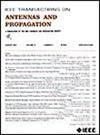Nonorthogonal Polarized MIMO Antenna for Simultaneous Transmit and Receive in Wi-Fi-Based Integrated Sensing and Communication
IF 4.6
1区 计算机科学
Q1 ENGINEERING, ELECTRICAL & ELECTRONIC
引用次数: 0
Abstract
Simultaneously suppressing self-interference (SI), crosstalk interference (XI), and multiple-input-multiple-output (MIMO) interference over a wideband presents significant challenges in a simultaneous transmit and receive (STAR) MIMO antenna. This article presents a基于wi - fi的集成传感与通信中同时收发的非正交极化MIMO天线
同时抑制宽带上的自干扰(SI)、串扰(XI)和多输入多输出(MIMO)干扰对同时发射和接收(STAR) MIMO天线提出了重大挑战。本文介绍了一种$2\ × 2$ STAR MIMO天线,该天线利用通常的堆叠贴片阵列,同时有效地抑制整个5 ghz Wi-Fi频谱中的所有三种类型的干扰。此外,当该天线的TX-RX偏振在一个通道内和通道间同时非正交时,可以实现这些干扰抑制。在这项工作中,提出了一种带宽带耦合调整(BCA)方法的圆偏振-线性偏振(CP-LP)方案,通过在残余的tx - rx耦合之间产生宽带抵消来最小化SI。在地面上设计了带槽结构的金属墙,在保持天线阻抗匹配的同时防止了信道间的干扰。构造了非正交极化STAR MIMO天线样机,仿真结果与实测结果吻合较好。在$5.1\sim $ 5.85$ GHz时,它同时抑制-40 dB以下的所有三种干扰,TX的峰值增益超过7 dBi, RX的峰值增益超过8.7 dBi,使该天线有望用于基于wi - fi的集成传感和通信(ISAC)。
本文章由计算机程序翻译,如有差异,请以英文原文为准。
求助全文
约1分钟内获得全文
求助全文
来源期刊
CiteScore
10.40
自引率
28.10%
发文量
968
审稿时长
4.7 months
期刊介绍:
IEEE Transactions on Antennas and Propagation includes theoretical and experimental advances in antennas, including design and development, and in the propagation of electromagnetic waves, including scattering, diffraction, and interaction with continuous media; and applications pertaining to antennas and propagation, such as remote sensing, applied optics, and millimeter and submillimeter wave techniques

 求助内容:
求助内容: 应助结果提醒方式:
应助结果提醒方式:


